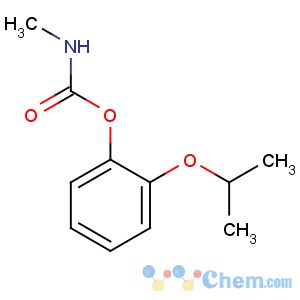Title: Propoxur
CAS Registry Number: 114-26-1
CAS Name: 2-(1-Methylethoxy)phenol methylcarbamate
Synonyms: o-isopropoxyphenyl
N-methylcarbamate; aprocarb
Manufacturers' Codes: Bay 39007; Bay 9010
Trademarks: Baygon (Bayer); Bifex (Provet); Blattanex (Bayer); Propyon (Makhteshim-Agan); Suncide (Bayer); Unden (Bayer)
Molecular Formula: C11H15NO3
Molecular Weight: 209.24
Percent Composition: C 63.14%, H 7.23%, N 6.69%, O 22.94%
Literature References: Prepn:
US 3111539 (1963 to Bayer; Chemagro Corp.). Properties: W. Behrenz, E. Boecker,
Pflanzenschutz-Nachr. Bayer (Ger. Ed.) 18, 53 (1965). Toxicity data: T. B. Gaines,
Toxicol. Appl. Pharmacol. 14, 515 (1969). Efficacy vs fleas and ticks in domestic animal collars: R. G. Hughes,
Vet. Med. Rev. 1, 80 (1985). Teratogenicity study: K. D. Courtney
et al., J. Environ. Sci. Health B20, 373 (1985). Environmental fate and LC/MS determn: L. Sun, H. K. Lee,
J. Chromatogr. A 1014, 153 (2003).
Properties: Minute crystals, mp 91.5°. Dec at high temp forming methyl isocyanate. Sol in methanol, acetone and many organic solvents, but only slightly sol in cold hydrocarbons. Water soly about 0.2% at 20°. Unstable in highly alkaline media. LD50 orally in male, female rats: 83, 86 mg/kg (Gaines).
Melting point: mp 91.5°
Toxicity data: LD50 orally in male, female rats: 83, 86 mg/kg (Gaines)
CAUTION: Potential symptoms of overexposure are miosis, blurred vision; sweating, salivation; abdominal cramps, nausea, diarrhea, vomiting, headache, weakness, muscle twitching.
See NIOSH Pocket Guide to Chemical Hazards (DHHS/NIOSH 97-140, 1997) p 266.
Use: Insecticide.

